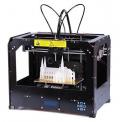Results 1 to 6 of 6
Thread: 3D printer vending machine
-
09-20-2015, 10:08 AM #1Student

- Join Date
- Sep 2015
- Location
- Houston, Tx
- Posts
- 3
3D printer vending machine
Hello everyone!
I'm new to 3D printing and this forum. I've read through many of the threads and I think I've found the right place. I am a mechanical engineer student working on my senior design project (see thread title) and I have some general questions that I hope experienced 3D printer users may graciously answer for me.
Background on the project: A problem arises in a university with a 3D printer available to students - the next person printing has to wait for the first person to remove their print (possibly perform some maintenance as well). The solution should be simple - design a mechanism that removes completed prints and stores it in a secure compartment for retrieval by the owner at a later time. Hence, a 3D printer vending machine.
Questions:
1. From your experience using 3D printers, how difficult is it to remove a completed print from the base( or printing surface)? Do prints readily slide off? do they require prying with a tool?
2. In general, do 3D printers require much "cleaning" between prints? what is the maintenance schedule? are some printers better in terms of maintenance than others?
Those are all my questions for now. Thank you in advance for your reply.
-Jon
-
09-20-2015, 11:42 AM #2
Sorry, I think the required cleanup and maintenance will kill your idea,
with the present printer technology.
There are too many Variables now !
3d printing is Not as easy as it first sounds ! LOL
Hopefully someday it Will be That Easy !
There are Many methods of adhesion and removing printed objects from printer,
Everyone has their preferred way, and usually a 'matter of opinion' as to which is Best.
I prefer the thin layer of Aqua-net spray on Glass-sheet method,
and not all objects can be removed the same way.
Some can be removed by light Tapping at base but others require gentle prizing first, if it has delicate areas at base.
It also makes a difference if a Raft option is selected, which puts extra plastic under first layers.
Some objects need a Raft and extra supports but those with Flat bottom usually do Not,
unless it has overhang areas.Last edited by EagleSeven; 09-20-2015 at 12:34 PM.
-
09-20-2015, 12:39 PM #3
Not knowing much about FDM printers, to get the workflow you're seeking I would think about a removeable build platform. Depending on how much engineering you're gonna put into the modification, I could envision a system where a stack of build platforms gets fed sequentially: modular so that electrical contacts at the platform edge provides any necessary power to stuff like heating elements. After printing, the entire platform and attached print is pushed off and another clean platform comes in. Each consumer would then be responsible for separating the print from the platform instead of developing more complications on the printer-side.
-
09-20-2015, 01:29 PM #4Student

- Join Date
- Sep 2015
- Location
- Houston, Tx
- Posts
- 3
@CarterTG
Thanks for the input. This was an idea my group and I talked about. If we have a finite number of compartments for storage then each compartment will have its own platform. I like this method, but modifying the actual printer to allow an exchangeable platform sounds like a nightmare. My concern is how sensitive the print head may be to changes to the vertical location of the print platform. would we have to ensure the new platforms are at the exact elevation as the original fixed platform?Last edited by Jon-A-Thon; 09-20-2015 at 01:36 PM.
-
09-20-2015, 01:36 PM #5Student

- Join Date
- Sep 2015
- Location
- Houston, Tx
- Posts
- 3
@EagleSeven
Thank you for the input. I've heard the maintenance (cleaning) is a huge hurdle. The raft option sounds interesting and i'll look in to that.
When you say 'many methods of adhesion...' does that have to do with the material used or something you have to apply to the base before printing?
Also, you say the glass-sheet method, does this mean that the printer will know to begin printing at the surface of the glass and not crash into it?
-
09-20-2015, 02:08 PM #6
There are many of Both the adhesive type used and what is on bed-plate that adhesive is applied to.
I like glass-sheet since it is very flat and Smooth surface, unlike painters-tape, thin-film sheet, etc.
I like Aqua-net spray adhesive since it has just the correct amount of holding strength and is easy clean-up with just a wet-cloth.
No scraping or solvents needed, for clean-up, like some other adhesives used.
Nozzle height must be changed to compensate for extra thickness added by glass-sheet.
Printer bed-plates also have spring loaded adjusting screws, that are used to make small adjustments,
to get the correct clearance between nozzle and the glass-sheet, for first printed layer.
There are alignment procedures in the printer's Firmware to assist in that.
Aqua-net spray can also be used to attach glass to bed-plate,
Takes about a week for it to completely dry, under the glass, since no air gets to it there
Must use clips to hold it in place until it dries.Last edited by EagleSeven; 09-20-2015 at 02:36 PM.




 Reply With Quote
Reply With Quote





Extruder not feeding during print,...
Yesterday, 01:59 AM in Tips, Tricks and Tech Help